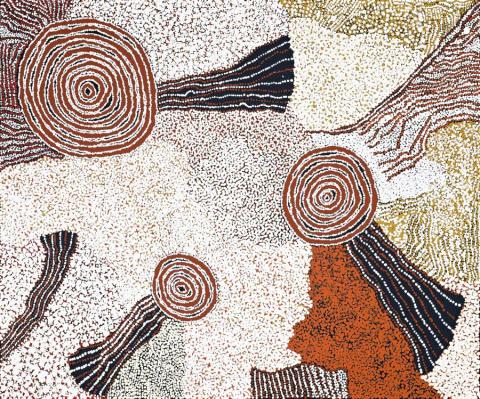ROCK HOLES NEAR THE OLGAS, 2008
BILL WHISKEY TJAPALTJARRI
synthetic polymer paint on linen
153.0 x 183.5 cm
inscribed verso: artist's name, size and Watiyawanu Artists of Amunturrngu cat: 3-08433
Watiyawanu Artists of Amunturrngu, Mount Leibig
Japingka Gallery, Fremantle
Private collection, Melbourne
This work is accompanied by a certificate of authenticity from Watiyawanu Artists of Amunturrngu
In December 2004, aged 85, after having watched the women at Amunturrungu (Mount Liebig) paint in the new 'Watiyuwanu' art centre for some time, Bill Whiskey (Mindinderi) walked in one day, sat down and began to paint. His paintings executed with an immediate and distinct authority, rapidly drew attention to him and granted him almost instant fame.
In the space of a few short years he created an astonishing body of paintings that quickly entered major international, national and private collections. In 2006 and 2007 he was a finalist in the Telstra National Aboriginal and Torres Strait Islander Art Award.
Born around 1920 in the Pirupa Akla (Olgas) area, Pitjantkatjara country, Bill Whiskey first ate white man's food as a young man when he and some community members wandered into the small mission (now the Areyonga Community). The white pastor (Patupirriit) didn't notice the food being tossed behind their backs. They were suspicious of its taste. Whiskey eventually moved to the outstation of Amunturrungu with his wife Colleen Nampitjinpa where they both held prominent roles as Ngangari (traditional healers). There are stories that at night Bill Whiskey would leave his body and fly over the landscape. Upon his return he would report on what he had seen.
This painting deals with events related to the story of the ancestral white cockatoo, which took place near the artist's birthplace at the rock holes of Pirupa Alka (rock holes near the Olgas and Uluru.) The depiction of country is also associated with the journeys Bill Whiskey made as a young man to Areyonga and Haasts Bluff. The variegated surface and mixed palette and the sheer scope of its recording of Country is handled with a virtuosic delicacy evocative of filigree. The subtlety of the shifting rhythms controlled on a monumental scale by the density and variety of dotting. The hovering roundels together with the heady use of colour (red, gold and ochre with an extensive overlay of white on a black ground) lend this work a shimmering radiance seen only in the best of the small number of large works he executed.
Like the great early Papunya Tula artist Johnny Warrangkula Tjupurrula, Bill Whiskey didn't restrict dots to the role of infill or mask to hide secret features. Instead, he engaged them more ambitiously as major compositional device in order to depict key typographical features. Likewise, the predominance of white is not incidental as it's intimately connected to his Cockatoo Dreaming in which white quartz stones are the feathers shed and scattered in the Cockatoo's terrible battle to ward off the murderously amorous Crow. The roundels, as explained by Nicholas Kachel, can represent either 'the holes made by the cockatoo and crow during their fight, or the specific rockholes used by Tjapaltjarri's family as dependable sources of fresh water'.1 The vivid coloured areas represent bush tucker and flowers bursting forth according to the seasons.
Finally, it is the sustained microscopic control of detail in his paintings, the tracery of dotted lines representing walking tracks in the lower and upper corners combined with a powerful composition that distinguishes this important work. Two perspectives, one aerial and another intimately connected to the knowledge of the ground, as experienced or read by feet on sand are interwoven. Here is a complex perspective at once intimately focused and cosmologically unbounded.
1. Nicholas Kachel, Bill Whiskey Tjapaltjarri, Exhibition catalogue essay, John Gordon Gallery, 2007
CRISPIN GUTTERIDGE
